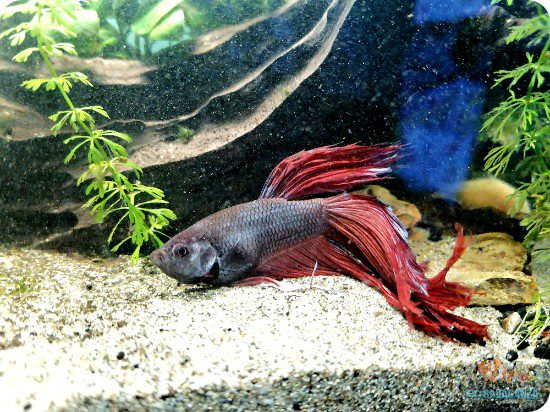Bettas are resting at the bottom of the tank sometimes. It’s important to know when it’s just chilling or if it’s sick.
Bettas can breathe air from the top, but they need to sleep too. If my betta is down there more than normal, I look closely to see why. Maybe the water’s bad, or it’s not feeling well.
I always watch my fish friend carefully to figure out what’s up. If you have a betta, you should know why it might lay at the bottom and how to keep it healthy.
Mike’s Thoughts
Betta fish occasionally resting at the bottom of their tanks might not always indicate a problem, but it’s important to be vigilant.
Observing any abnormal behavior or signs of illness is crucial for your pet’s health.
Regular water quality tests for ammonia and nitrate levels and a keen eye for any illness are essential.
Ensuring that your betta’s environment is clean and well-structured, with ample hiding places, is a proactive step towards preventing health issues.
If you notice your betta spending too much time at the bottom, it’s worth considering these aspects to maintain a healthy habitat.
I’ve put a bunch more detail below that expands on the topic, so feel free to read on and leave a comment if you have any questions or reach out to me on Facebook.
Reasons Betta Laying On Bottom Of The Tank
Understanding Betta Behavior
To grasp why a betta fish might lay at the bottom of the tank, it’s important to consider their natural behaviors and environmental needs.
Betta fish have their own sleep cycles. Just like us, they need rest. It’s normal for them to nap during the day and sleep at the bottom when it’s dark.
But sometimes, if you see your betta fish laying down too much, it could be a sign they’re not okay. For instance, if the water’s dirty, it can make them sick.
Things like ammonia poisoning and poor water quality are bad news for bettas.
They need clean water with the right water parameters.
Otherwise, they can get stressed, stop eating, and lay at the bottom a lot. It’s a way for them to tell us they need help.
Health problems like swim bladder disease can also make it hard for bettas to swim. That’s why they might rest at the bottom.
If you notice these signs of illness, it’s a red flag. It means it’s time to check the water and see if they’re sick.
Understanding betta behavior helps us take better care of them.
Tank Size
If your betta fish is laying at the bottom of the tank, it could be because of a small aquarium.
Betta fish need at least a 5-gallon, fully-cycled aquarium to thrive.
No products found.
In smaller tanks, bettas can get stressed and water quality can suffer, leading to health problems.
A larger tank provides more space for swimming and helps maintain stable water conditions, keeping your betta healthy and active.
Wrong pH
You know, having the wrong pH in your betta fish tank can be even worse than having the wrong water temperature.
In the wild, betta fish like slightly acidic water, but most of them can handle a more neutral pH around 7.0.
No products found.
It’s important to keep the tank pH between 6.0-8.0, but remember, small changes in pH can actually have a big impact because of the logarithmic scale it’s measured on.
It’s normal for pH to change during the day, especially in a well-planted tank, but if it changes by more than 0.5 pH in a day, it can really stress out or even harm your betta fish.
Sleep Patterns
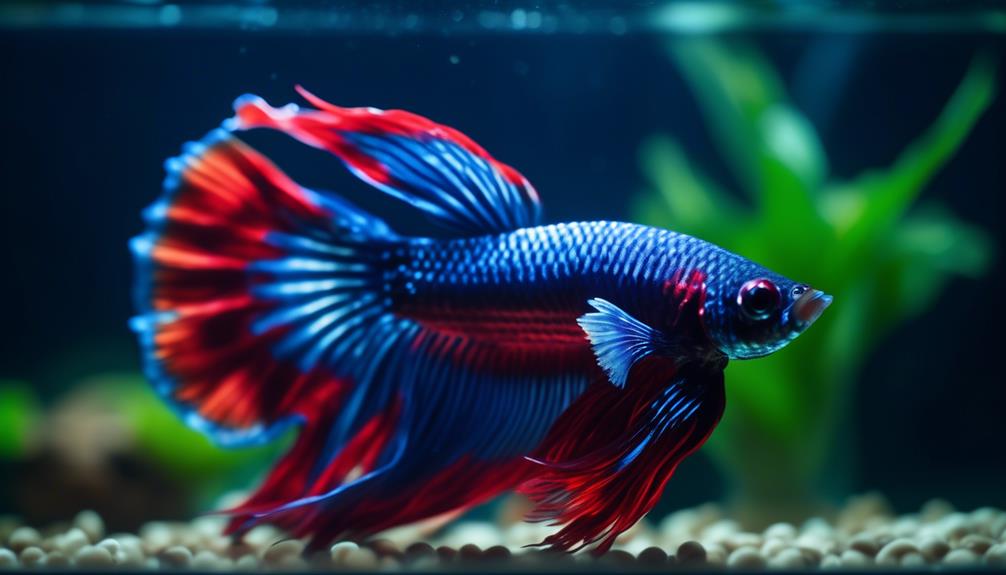
Understanding the sleep patterns of betta fish is key to ensuring their well-being, as they exhibit unique resting behaviors that can include sleeping at the bottom of their tank.
Seeing your Betta laying at the bottom might worry you, but it’s important to know that this can be normal behavior.
Since fish don’t have eyelids, it’s tricky to spot when they’re snoozing.
Here’s a quick rundown of what you should know about Betta fish sleep:
- Floating Snooze: Bettas often sleep by lightly floating near tank decorations or plants.
- Bottom Rest: It’s normal for a Betta fish to lay at the bottom of the tank, especially at night.
- Naps and Nocturnal Rest: Betta fish may take short naps during the day and have a longer sleep at night.
- Lights Out: To support their sleep patterns, it’s best to turn off the tank lights at night.
Age-Related Inactivity
As betta fish gets older, I’ve noticed it’s spending more time resting at the bottom of the tank.
This seems to be a part of their normal aging process, as their activity levels naturally decrease.
It’s important to keep an eye on their health, though, as old age can bring about changes that need attention.
Senior Betta Behavior
Many senior betta fish show less activity as they age, often resting at the bottom of the tank as part of their natural aging process.
It’s important to know that this behavior doesn’t necessarily mean they’re unwell. Here’s what to consider:
- Normal Behavior: Senior betta behavior includes laying on the bottom more often.
- Health Check: Keep an eye on their health and happiness, even if they’re less active.
- Comfort Matters: Create a comfortable environment so your Betta might thrive even at the end of its life.
- Observation is Key: Regularly check if laying at the bottom is coupled with any signs of distress.
Understanding these aspects ensures I’m providing the best care for my aging betta.
Lifespan Impact on Activity
Recognizing these behavioral patterns in my senior betta, I’m now more aware that as they approach the end of their lifespan, increased periods of inactivity are a normal part of their development. It’s a stark reminder that bettas live for only a few years, and seeing my fish laying on the bottom of the tank more often is a sign of their age, not necessarily that I have a sick betta.
Here’s a simple table that touches on what I’ve noticed:
| Age Stage | Activity Level | Emotional Response |
|---|---|---|
| Youth | Very Active | Joyful |
| Adult | Active | Content |
| Senior | Less Active | Concerned |
| Old | Inactive | Accepting |
| End | Still | Reflective |
Even with the right water temperature and care, a healthy Betta will show this cycle. I’m committed to making every stage as comfortable as possible for my little friend.
Old Age Symptoms
In their twilight years, betta fish often show age-related inactivity by resting more at the bottom of their tanks.
When I see my betta fish laying at the bottom of the aquarium, I consider old age symptoms before assuming my betta is sick.
Here’s what I’ve learned about Bettas might exhibit as they age:
- Increased time spent staying at the bottom, showing less interest in swimming.
- Fatigue, leading to less flaring and fewer vibrant displays.
- Slower reactions to food or changes in the environment.
- Possible changes in coloration and fin condition.
It’s crucial to keep their water clean since poor quality can worsen these symptoms. I always check for ammonia and nitrate levels to ensure it’s not harming my aging friend.
No Compatible Tank Mates
When choosing tank mates for your betta fish, avoid adding overly active or aggressive fish that may stress or injure your betta.
Not all bettas are welcoming to other fish, so success will depend on each betta’s personality.
Choose tank mates carefully to ensure a successful pairing.
Avoid schooling fish, african dwarf frogs, gouramis, cichilds, goldfishs, most shrimps and maybe other bettas.
Ammonia Poisoning
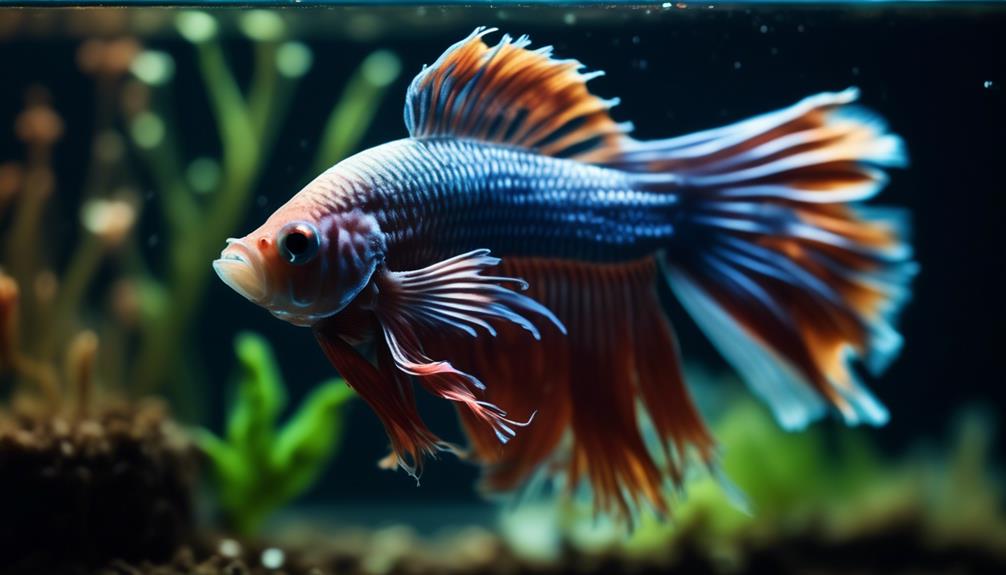
I’ve noticed my betta fish acting strangely and it’s got me worried about ammonia poisoning.
It’s important that I recognize the symptoms early and figure out how to manage ammonia levels in the tank.
If there’s an emergency, I need to know the right steps to take to help my fish.
Recognizing Ammonia Symptoms
Betta fish showing signs of erratic swimming or gasping at the water’s surface may be suffering from ammonia poisoning. It’s vital to recognize these symptoms quickly:
- Erratic swimming or gasping for air indicates high ammonia levels.
- Red or inflamed gills, lethargy, and loss of appetite are serious signs.
- Look for excessive mucus, changes in skin color, or fin deterioration.
- A Betta fish lying at the bottom may be experiencing nitrate poisoning.
To combat this, I ensure to test my water regularly and perform water changes to maintain safe levels. It’s crucial to keep an eye on these symptoms, as they can quickly lead to severe health issues for my Betta Fish.
Immediate action, like water changes, can save them from the toxic effects of ammonia.
Ammonia Levels Management
Keeping my betta fish healthy involves management of ammonia levels to prevent the distressing signs of poisoning.
I make sure to regularly test the water in my betta tank.
No products found.
When ammonia spikes, my fish might gasp for air or show red, sore gills. It’s a clear sign I need to act fast.
I’ve learned that regular water changes are crucial.
They keep the water clean and stop ammonia from getting too high.
I replace part of the water volume often to dilute any ammonia. This also helps beneficial bacteria thrive. They break down the ammonia, keeping the tank safe.
If I don’t manage the ammonia levels, the water quality will suffer. It can lead to poor health for my betta, and I can’t let that happen.
Emergency Ammonia Interventions
While managing ammonia levels is key, it’s equally important to know how to react when my betta shows signs of ammonia poisoning. If I notice any troubling symptoms, I’ve got to leap into action with emergency ammonia interventions. Here’s what I do:
- Test the Water: I check the ammonia levels immediately. High levels are toxic!
- Change the Water: I swap out a good portion of the tank water regularly to dilute the ammonia.
- Adjust pH Levels: Keeping the pH level stable helps minimize the toxicity of ammonia.
- Monitor My Betta: I watch for any signs of recovery or further distress.
Nitrate Toxicity

To ensure the health of your betta fish, it’s crucial to regularly test the tank water for nitrate levels using a reliable test kit.
When these levels get too high, nitrate toxicity can make your betta sick. I keep an eye out for signs that something’s wrong.
If my betta starts gasping for air at the surface, seems unusually tired, or doesn’t want to eat, it could point to nitrate issues.
I also look over my betta for any physical symptoms. Pale gills, a darker skin color, or swelling around the gills and fins are red flags for me. It’s important to catch these signs early.
The condition of their water tank can also tell me a lot.
A sudden algae bloom, a nasty smell, or cloudy water might mean the nitrate levels are too high.
I make sure to think about what’s changed in the aquarium lately. Feeding them too much, slacking on water changes, or having too many fish can all lead to a spike in nitrates.
Good water quality is key to a healthy betta fish. If I spot any of these issues, I do a water change right away to bring the nitrate levels down.
It’s one of the best ways to keep my betta fish safe from nitrate toxicity.
Fin Rot
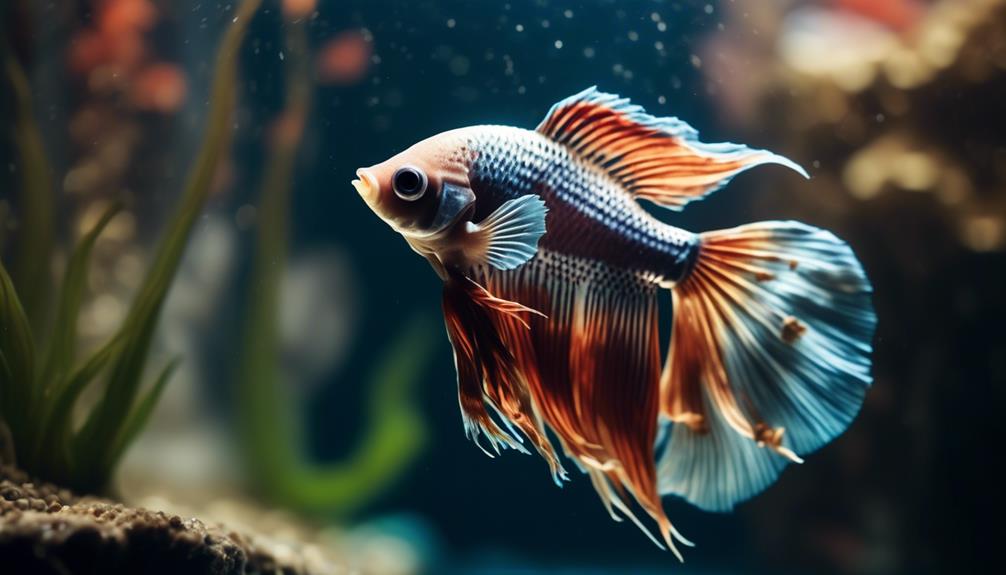
When I notice my betta’s fins are looking torn or their color is off, I know it’s time to consider fin rot.
Treating fin rot quickly is crucial to get my fish swimming happily again.
I also make sure to take steps to prevent this problem from coming back in the future.
Identifying Fin Rot Symptoms
Recognizing fin rot in betta fish is crucial, and the first signs often include their fins appearing frayed or disintegrating.
If I notice my betta fish is laying on the bottom of the tank, it’s time to closely inspect for other symptoms. Here’s what I look for:
- White edges or discoloration on the fins, suggesting the tissues are breaking down.
- Sluggish behavior and a lack of appetite, which can indicate discomfort from fin rot.
- Inflammation or redness at the base of the fins, sometimes with bloody streaks.
- White or gray patches on the fins, potentially signaling a fungal component to the fin rot.
I know that regular water changes are key to preventing fin rot and keeping my betta healthy.
Treating Fin Rot Effectively
After confirming the signs of fin rot in my betta fish, I’m ready to tackle the infection with effective treatments.
I’ve noticed shredded fins and discoloration, along with my fish showing less energy and a drop in appetite.
Every time I peer into the betta fish tank, I’m reminded of how crucial clean aquarium water is for their health.
I’ve been serious about water changes and monitoring the water parameters, making sure ammonia and nitrate levels are in check.
They stressed the importance of an appropriate tank environment and recommended keeping an eye on tank mates that might stress my betta.
Treating fin rot quickly and effectively is key.
Preventing Future Fin Rot
To prevent future bouts of fin rot in my betta fish, I’ll maintain clean water through regular tank cleaning and water changes. Here’s how I plan to keep my betta healthy:
- Regular Water Changes: I’ll change 25-30% of the tank water weekly to minimize toxins.
- Appropriate Tank Size: I’ve made sure my betta’s home is spacious enough to swim freely, which reduces stress and prevents fin rot.
- Neutral pH and Stable Water Conditions: I’ll use a test kit to monitor the pH, keeping it neutral. An aquarium heater will help maintain a consistent temperature that’s just right for my betta.
- Environment Enrichment: I’ll include live plants for natural cover and ensure the water flow is gentle to mimic their natural habitat.
Columnaris Infection
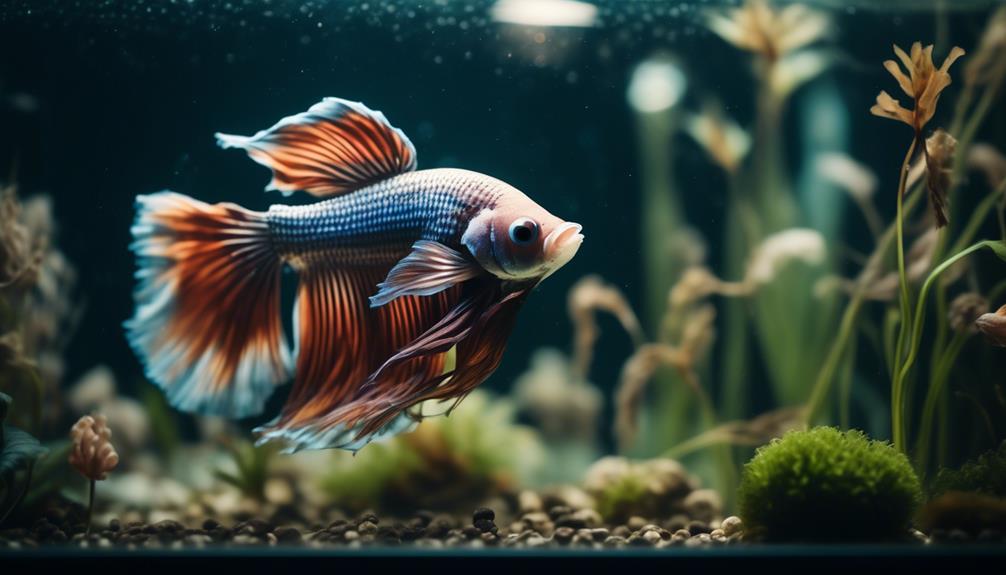
Spotting Columnaris infection in betta fish means looking for the telltale white or grayish spots that resemble cotton on their bodies, fins, or gills. If I see my betta laying on the bottom of the tank, it’s a red flag.
Identifying Columnaris infection quickly is crucial because it’s highly contagious and can spread fast.
Here’s a simple table that shows what to look out for:
| Symptom | Columnaris Infection |
|---|---|
| Patches on body | White or grayish spots like cotton |
| Behavior | Lethargy, loss of appetite |
| Fins and gills | Frayed fins, difficulty breathing |
To ensure your betta’s health, add aquarium plants for better water quality and make sure you’re on top of any signs of illness. If Columnaris is confirmed, isolate the infected fish and start treatment with antibiotics. Remember, a healthy tank means a happy betta!
Eyecloud
The treatment includes removing your Betta from the tank, giving him or her a saltwater soak, and administering an antibacterial medication.
Eyecloud happens when the cornea gets inflamed, not to be confused with pop eye, which is when the eye bulges.
It can be caused by infection, poor water quality, or eye trauma. Symptoms include a cloudy or milky appearance, redness or discharge, and eye swelling.
Treatment involves removing the Betta from the tank, giving a saltwater soak, and using antibacterial medication.
Tuberculosis
Deadly and can spread through open wounds or contaminated food. The bacteria live in salt and fresh water.
Symptoms may include:
– Loss of appetite
– Weight loss
– Lethargy
If the infection gets worse, symptoms become severe. The Betta may lose scales, have open sores, and a fraying tail. It’s serious!
There’s no cure. Try to prevent your dying Betta fish from suffering. Giving it a humane death will save it a lot of pain.
One humane way to euthanize a fish is by using clove oil. Here are the steps to follow:
1. Prepare a separate container of water from the fish tank and add a small amount of clove oil to it. The recommended ratio is around 10 drops of clove oil per liter of water.
2. Gently transfer the fish to the container with the clove oil-infused water.
3. The clove oil will sedate the fish, eventually leading to its passing.
It’s a difficult decision, but it’s important to ensure that the fish does not suffer needlessly. If you need further guidance on this process or any other questions, feel free to ask.
Velvet Disease
Velvet disease is a deadly parasitic infection. Many things can carry it into your tank since it’s usually spread unknowingly from another location. Note: Remember this if your fish came from a pet store aquarium.
This disease causes fish to become orange-ish or rust-colored, so if your Betta is already orange, it can be tough to recognize. The parasite can also catch a ride into your tank via:
| Carrier | Method of Spread | Notes |
|---|---|---|
| Fish | Direct contact | Can introduce the parasite to the tank. |
| Snails | Attachment to surfaces | Can carry the parasite on their shells. |
| Shrimp | Direct contact | Can carry the parasite into the tank. |
| Plants | Attachment to surfaces | May harbor the parasite and introduce it to the tank. |
| Filters | Transport medium | Can transfer the parasite from one tank to another. |
| Decorations | Transport medium | Can harbor the parasite and introduce it to the tank. |
Ich Disease
Ich is a tiny parasite that can be deadly for fish in aquariums. You can easily spot the white dots on the fish that indicate this disease. Fortunately, seeing these dots means the parasite is in its early stage, so there’s time to treat it.
| Information | Description |
|---|---|
| Disease Name | Ich Disease |
| Pathogen | Protozoan parasite |
| Common Name | White Spot Disease |
| Appearance | White spots on fish |
| Transferable Via | Fish, Invertebrates, Plants, Decorations, Maintenance equipment (Gravel vacuum or nets) |
| Severity | Deadly, but treatable in early stages |
Hemorrhagic Disease

When I noticed red streaks on my betta’s fins and a lack of energy, I realized it might be hemorrhagic disease, a serious condition requiring immediate attention.
My betta fish was also laying on the bottom of the tank more than usual, which was another red flag.
Here’s how I went about treating my betta:
- Quarantine: I moved my betta to a separate tank right away. This helped prevent the disease from spreading to any other fish I had.
- Water Quality Assessment: I tested the water for ammonia, nitrites, and nitrates. It was crucial to keep the water in the best condition to aid recovery.
- Medication: I got medicine recommended by a fish vet and followed the dosage instructions carefully. I made sure not to miss any treatments.
- Monitoring: I kept an eye on my betta throughout the treatment, making sure the environment stayed stress-free. If things didn’t get better, I was prepared to seek more help from the vet.
I also made regular water changes and offered high-fiber foods, as bettas from Southeast Asia are used to a varied diet.
This disease is tough, but with careful attention, I hoped my betta would pull through.
Dropsy
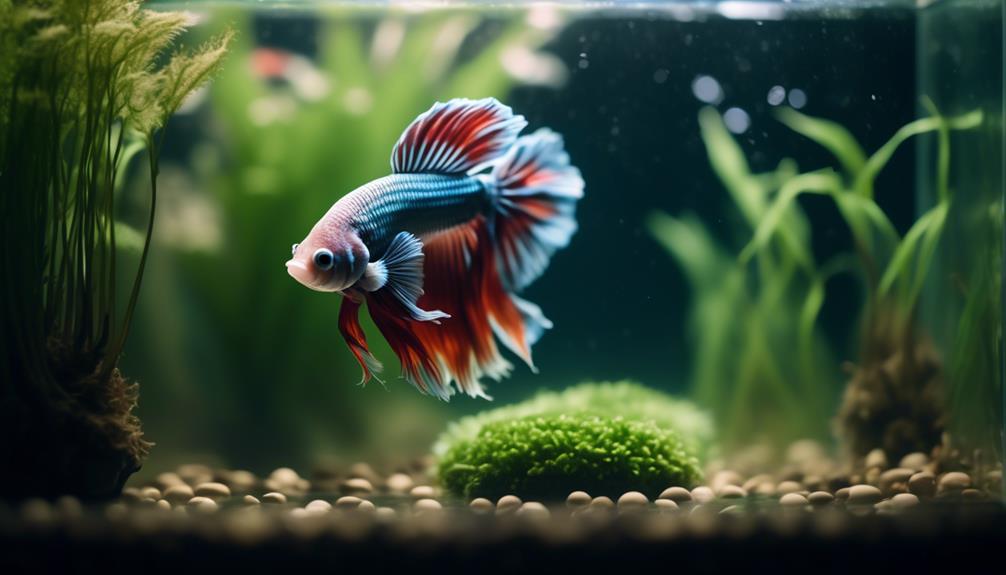
I noticed my betta’s abdomen swelling and scales protruding, indicating it was likely suffering from dropsy, a condition I knew required swift action.
Dropsy can cause the fish to retain fluid and develop a pinecone-like appearance.
To manage the symptoms, I first made sure to keep the water clean. Regular water changes are key.
I performed water changes more often to reduce the toxins that could worsen my betta’s condition.
Maintaining slightly acidic water also seems to help your Betta stay healthy.
I adjusted the pH carefully, aiming for a level that supports my betta without causing stress. I also increased the temperature a bit to support its immune system, making it easier for my fish to fight off infection.
I watched for other symptoms like pop eye, which can accompany dropsy.
By managing these signs early, I aimed to prevent further complications. I paid close attention to my betta’s behavior and appetite, adjusting its diet to include foods that are easy to digest.
In all, managing dropsy symptoms involved constant vigilance and prompt action. It’s crucial to act fast and provide the right care to give your betta the best chance at recovery.
Swim Bladder Issues

Tackling swim bladder issues in betta fish requires maintaining ideal water conditions and a balanced diet. If I see my betta lying at the bottom of the tank, I know something’s wrong.
It’s a sign that the poor living creature might be struggling with its swim bladder. To help my betta, I follow these steps:
- Check Water Quality: Frequent water changes are key. I make sure ammonia and nitrite levels are at zero and nitrate levels are low. Stable water conditions mean my betta won’t go into shock, which can happen with aggressive fish like them.
- Adjust Their Diet: I feed high-fiber foods like daphnia or brine shrimp. These help prevent constipation, a common cause of swim bladder issues.
- Create a Stress-free Environment: I add live plants and hiding spots in the tank. This reduces stress that can affect my betta’s swim bladder.
- Monitor and Act: If I notice signs of constipation, I adjust their diet. Should the problem persist, I’m ready to seek veterinary care for a proper diagnosis and treatment plan.
I’m always on alert for these issues because I care about my betta’s health and happiness.
Low Quality Food
In the wild, betta fish eat a variety of plants, algae, insects, and detritus, but in an aquarium, high-quality fish flake or pellet food provides the necessary nutrition for them to thrive.
No products found.
Low-quality or inappropriate foods can lead to malnourishment, weakness, and digestion problems for bettas, so it’s important to feed them well to keep them healthy and active.
Ideal Temperature
Water temperature is a crucial factor for betta fish, as they require a constant temperature between 78-80°F (26-26.5 Celsius), and fluctuating temperatures can cause them to go into shock and become lethargic or die, so it’s important to use an aquarium heater for temperature stability.
No products found.
Many betta fish are kept in unheated aquariums due to misinformation, but it’s essential to provide them with the right conditions for their well-being.
Adequate Filtration
Betta fish need a properly sized filter (assuming you have already solved the heater) rated for at least 5 gallons, which doesn’t push the fish around or cause poor water quality.
Many betta keepers face the problem of filters with too much water flow, leading to fish injuries and water quality issues.
No products found.
To solve this, consider using a sponge filter or modifying the water flow of the filter to ensure it can handle the tank’s bioload without overwhelming the fish.
Lack of freshwater aquatic habitat
When setting up your Betta’s tank, avoid using sharp decorations, metal items, or painted ornaments as they can harm your Betta.
Also, steer clear of seashells, beach sand, or dried coral as they can alter the pH.
Instead, consider adding plants to the tank, as they provide hiding spots, reduce stress, and offer safety for your Betta.
Keep an eye on the live plant growth to ensure it doesn’t impede your Betta’s ability to come to the surface for food and air.
Preventing Parasitic Infections
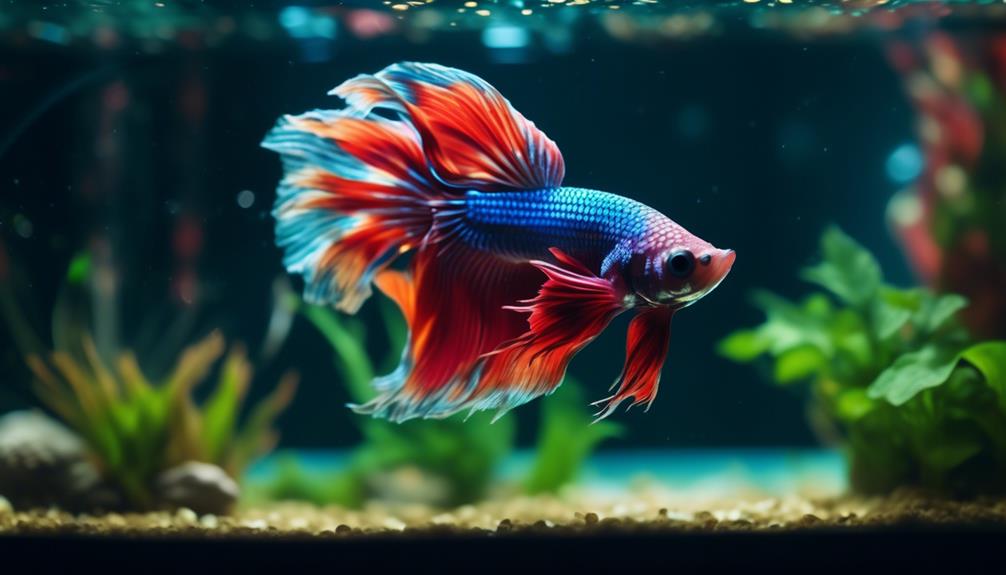
To prevent parasitic infections in my betta’s tank, I prioritize maintaining excellent water quality through regular changes and filtration.
It’s not just about keeping the tank looking nice; it’s about the health of my betta. Regular water changes are a must to keep the water clean and free from parasites that could harm my fish.
When I add new plants or fish, I always quarantine them first. It’s a simple step, but it’s crucial for preventing parasitic infections from spreading.
I also make sure not to overcrowd my betta’s home. Betta fish need space to swim and thrive, and an appropriately sized tank helps every fish stay healthy.
Here’s a quick table I put together to keep things on track:
| Good Practice | Reason |
|---|---|
| Regular water changes | Prevents parasites, keeps water healthy |
| Quarantine new additions | Stops parasites from entering tank |
| Avoid overcrowding | Reduces stress, lowers infection risk |
Frequently Asked Questions
Is It Normal for a Betta Fish to Lay on the Bottom of the Tank?
I’ve learned that a betta fish on the tank bottom could be resting, but it might also signal stress indicators, poor water parameters, or sickness.
I’ll check the tank size, nutrition, and decor hazards.
Why Is My Fish Laying on the Bottom but Still Breathing?
I’m worried because my fish is at the bottom, yet breathing. It might be stress signs, poor water quality, temperature changes, or inadequate filtration.
Could be ammonia poisoning, disease symptoms, or swim bladder issues.
Why Is My Betta Fish Laying on the Bottom of the Tank and Breathing Heavily?
My betta’s heavy breathing and bottom resting might signal stress response, disease symptoms, or ammonia poisoning.
It’s vital to check water quality, oxygen levels, temperature, and ensure there aren’t any nutritional deficiencies.
Why Does My Betta Keep Sinking to the Bottom?
I’m worried because my betta keeps sinking. It could be swim bladder problems, poor water quality, temperature shock, stress signs, diet issues, ammonia poisoning, or natural inactivity periods. I’ll check and fix these.
Why Betta Fish Laying on Side at Bottom of Tank?
Betta fish laying on their side at the bottom of the tank could be a sign of various health issues.
It could be due to stress, poor water quality, swim bladder disorder, or even a sign of an underlying illness.
It’s important to assess the water parameters such as temperature, pH, and ammonia levels to ensure they are within the appropriate range for betta fish.
Additionally, observing the fish for other symptoms such as loss of appetite, discoloration, or changes in behavior can help in identifying the problem.
If the issue persists, it’s best to consult with a veterinarian or a knowledgeable fish expert for further guidance.
Why Betta Fish Laying on Bottom of Tank and Breathing Heavily?
A betta fish laying on the bottom of the tank and breathing heavily could be a sign of various health issues. It may be experiencing stress, poor water quality, or a bacterial or parasitic infection.
It’s important to check the water parameters including temperature, pH, ammonia, and nitrite levels to ensure they are within the appropriate range for betta fish.
Observing any unusual behavior or symptoms such as loss of appetite, lethargy, or discoloration can help in identifying the issue.
I would recommend consulting a local veterinarian for further assistance in diagnosing and treating the fish.
Why Betta Fish Laying on Bottom of Tank After Water Change?
Betta fish may lay on the bottom of the tank after a water change due to stress, sudden changes in water parameters, or temperature fluctuations.
It’s important to ensure that the water temperature and quality are suitable for the betta fish.
You can also try adding some aquarium salt to help reduce stress and promote overall health.
Also check for any signs of illness or injury in the betta fish. If the behavior persists or if the fish shows any concerning symptoms.
Conclusion
A betta’s rest at the tank bottom might be normal, but it can also signal issues. It’s key to watch for signs like listlessness or disease.
Regular checks for ammonia, nitrate, and signs of illness are crucial.
A well-maintained, clean tank with hiding spots helps prevent problems.
If my betta’s often at the bottom, I’ll consider all these factors, ensuring it’s healthy and happy in its aquatic home.
